Red Fox Diet - Hunting Strategies & Behaviour
Now we know what foxes eat, and how much food they need, we arrive at the question of how they go about finding and catching their food. Red foxes are predominantly nocturnal and prefer to hunt late in the evening through until the early hours of the morning; consequently, they tend to have more food in their stomachs at night than during the daytime. Most foxes will patrol at least part of their territory each night, becoming acutely aware of where the best feeding sites are and when new food sources appear in the area.
They have a keen sense of smell and this can lead them to carrion, even buried under several centimetres of snow or soil. A fox's nose, however, is not only good for leading it to decomposing carcasses. Working on the Ravenglass-Drigg Sanctuary in Cumberland during the 1960s and 70s, Niko Tinbergen found that foxes could sniff out eggs he'd buried along one kilometre of "fox highway". Tinbergen observed that foxes could apparently detect an egg buried under three centimetres (about an inch) of sand from 50 cm (almost 2 ft) away. Foxes can no doubt detect many insect larvae and grubs in much the same way. Thus, it is likely that smell, coupled with regular tours of the territory, is sufficient to find much of their food; especially for foxes living on the open hills, where deer and sheep carcasses are important components of their diet, particularly during the winter.
Finding food is, however, one thing; catching it, quite another. In most cases, a fox's food isn't just lying around waiting to be stumbled upon -- it's very much alive and keen to remain that way. Consequently, foxes need to be capable of finding, stalking and catching live prey and this they do with impressive effect. Indeed, the literature is replete with examples of how foxes "cunningly" attract, trick and capture their quarry and, while much is myth, some is very much fact.
The pounce
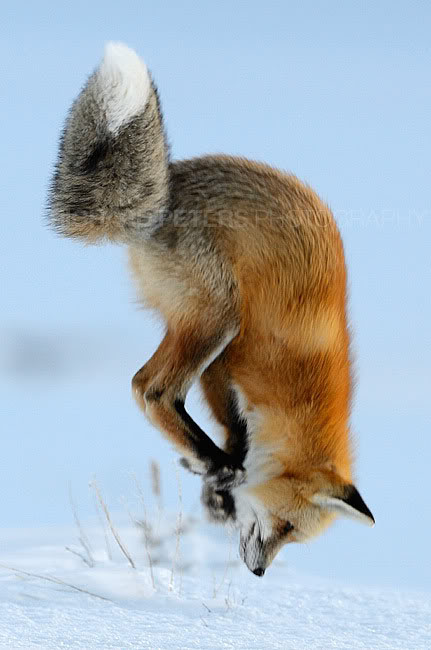
Red foxes have evolved as mousers, with a pouncing angle of around 40-degrees. Higher angles are needed to land with sufficient force to break a thick crust of snow. The down-side to this method of hunting is that the fox doesn't know what it has until it has caught the prey - unpalatable prey (such as shrews and moles) may subsequently be discarded.
One of the most familiar hunting strategies in the fox's arsenal is the "mousing pounce", which is employed when hunting small mammals (typically rodents). According to Lloyd, in his book The Red Fox, this pounce appears in a cub's behavioural repertoire at about six weeks of age, when it's used to catch insects in the vicinity of the earth. The precise angle of pounce depends on what and where the animal is hunting, but typically the sequence begins with the fox walking slowly with its head and tail low, moving its head from side to side. When prey is detected, the head and tail are raised and the ears cocked forward -- the fox remains motionless, listening and watching intently.
Once the fox has a good idea where its quarry is, it approaches slowly, stopping frequently to listen and, when it gets within striking distance, it rears on to its hind legs, bends its knees and jumps up, landing with its front paws on its quarry, which is quickly snapped up. In some instances the jump is relatively shallow, with the fox landing with front and back legs almost simultaneously. In most cases, however, the fox comes down with its front paws first (sometimes it reaches near vertical body position -- as shown in Richard Peters' excellent photo), landing with sufficient force to break a thick crust of snow. When rodents are caught they are generally swallowed whole, rather than being chewed. In his book, Wild Guide, Simon King notes that, if birds are caught, the foxes tend to pluck the breast feathers with their incisors before chewing off the wing feathers with their molars; the latter being harder to pluck.
David Henry, in his Red Fox: The Catlike Canine, analysed the pounce of the Red fox using video footage that he had shot of several pounces. Henry was able to calculate that foxes have a "take off" angle of 40-degrees (give or take about 6-degrees). This is interesting because conventional physics states that the optimal take-off angle for a missile (i.e., the angle at which it has to leave the ground in order to travel the greatest possible distance) is 45-degrees, so the fox is pretty close to optimal.
Henry suggested that foxes may take off at a slightly suboptimal angle because, were they to pounce at 45-degrees, they may become too conspicuous to their potential prey. To my mind it seems reasonable that a fox might also adjust its take off angle in accordance with its distance from its intended meal -- optimal distance is no good if you sail straight over the top of your dinner. Henry also observed that if the fox needed to land with additional force (to break a thick crust of snow, for example), it would aim much higher: about 80-degrees. Recently, researchers in Germany have found evidence that foxes may be able to use the Earth's magnetic field to accurately judge the distance to their prey (see: Senses).
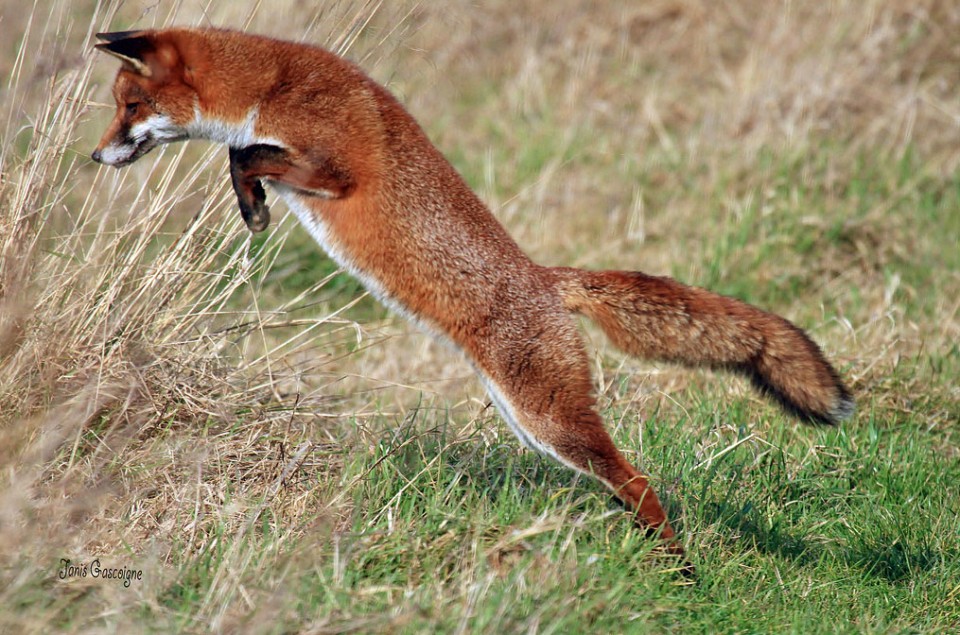
As mentioned, pounces are adapted as necessary to catch insects and also birds, but are of little use against larger mammals and soil-dwelling invertebrates and mammals (e.g., moles). Indeed, despite seldom being eaten, moles are located (presumably by sound) and dug out. Mice, voles and shrews are also hunted by sound; the fox pounces, collapsing the underground gallery in which the unfortunate target is sitting, and then digs the prey out. Earthworms are hunted from the surface as they emerge from their burrows and, in a 1980 paper, David Macdonald described how the foxes hunted worms by sound, stopping and listening intently before snapping and seizing a worm -- once the worm was held firmly between the incisors, the fox paused momentarily before slowly raising its head to pull the worm from its burrow and consume it whole.
Overall, it seems that the ability to pounce on prey is innate behaviour -- as is chasing or jumping on moving objects or those rustling in the undergrowth -- that is subsequently improved through practice and, possibly, guidance from their parents. Indeed, we know that hunting takes time and practice to perfect and as the cubs grow, and the food supply from their parents dries up, they're reliant on more easily caught prey until they have developed the motor skills and technique required to catch preferred prey. Recent work by the mammologists at Bristol University has found that earthworms and insects are crucially important prey for newly weaned cubs. Invertebrates provide nutrition in the first month after the parents stop feeding them, as they hone their hunting skills; their availability also influences their cubs' adult size.
Tackling larger prey
Larger prey, such as rabbits, hares, gamebirds and deer kids tend to be stalked and rushed at. Watching a fox hunt rabbits is an enthralling experience. The fox crouches low, belly to the ground, and staying low it runs quickly from one area of cover to another, where it stops and resumes the crouch. If no cover is available, the fox stalks across in the open, freezing periodically as the prey looks in its direction. When the fox judges it is within striking distance it "explodes" from its spot and a remarkable race ensues. As the fox runs it employs its tail as a counterbalance, as it twists and turns in pursuit of its prey.
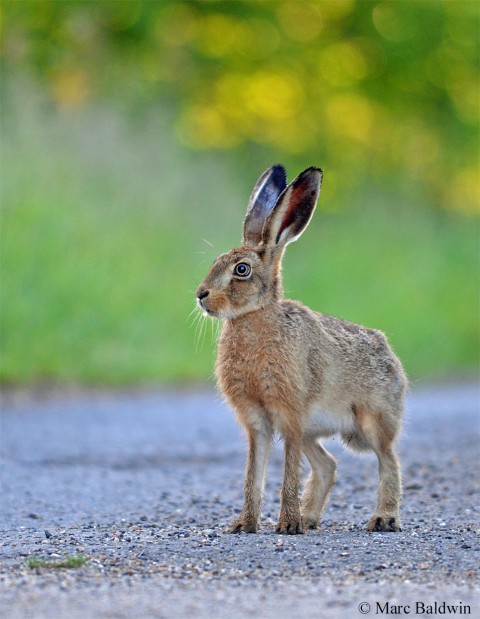
Foxes may also lie in wait for their rabbit quarry and the BBC's Tale of the Big Bad Fox documentary, aired in 1995, showed a fox unsuccessfully hunting rabbits -- many rabbits retreated underground while a few look outs above kept a wary eye on the fox and thumped an alarm call. In the gloom of the hedge, the fox lay down and simply waited; after a while the sentinel rabbits went back to grazing and, with no thumping from above, the other rabbits emerged from the warren, allowing the waiting fox to snatch himself a meal. Unfortunately, I have no statistics as to how successful foxes are when hunting rabbits, but I would be interested to hear from readers who have.
Foxes will also take rabbit kittens and, in most cases, these appear to be dug out of the stop (underground nesting chamber) by the fox. In their study of fox predation on young rabbits in northern Holland during the late 1970s, Jaap Mulder and Marijke Wallage-Drees, found that foxes tended to dig directly down into, or slightly to one side of, the nesting chamber, creating a distinctive oval or rectangular hole measuring an average of about 20 cm (8 in.) in diameter. Foxes obviously have a remarkable ability to detect the kittens underground and, given that they nearly always dig straight into the burrow, they can pinpoint them accurately under some 40 cm (1.5 ft) of soil; they presumably do this by sound. Perhaps more interestingly, was the finding by Mulder and Wallage-Drees that stop predation was very localised, offering support for the theories of earlier authors that predation of rabbit kittens in stops is not a general habit of all foxes, but a speciality of some individuals.
Foxes hunting hares are less frequently observed, but an account in Robin Page's 1986 book, A Fox's Tale, suggests they're approached more directly than rabbits. Page recounts the experience of a farmworker, who believed that foxes caught hares while they were sitting in their forms by approaching from the front. Page explained:
"According to him there were two reasons for this: firstly hares spend much of their time in their forms looking behind them, so they can often be approached directly. And secondly a hare always runs forwards from its form; consequently if the fox gets close enough, the hare runs towards it initially and its chances of escape are reduced as a result."
Food-finding folklore
In folklore, foxes are renowned for letting their food come to them -- that is to say, playing dead to attract curious and scavenging animals. In his story of the Springfield Fox, Ernest Thompson Seton described how a vixen demonstrated to her cubs how to catch squirrels; she'd lie "flat and lifeless" on the grass near the base of the tree and wait for the curious rodent to approach within striking distance. Despite an opening note to the reader saying that the stories in his compendium were true, many of Seton's tales are of dubious authenticity. There are, nonetheless, many similar stories of foxes apparently playing dead to attract prey to within striking distance.
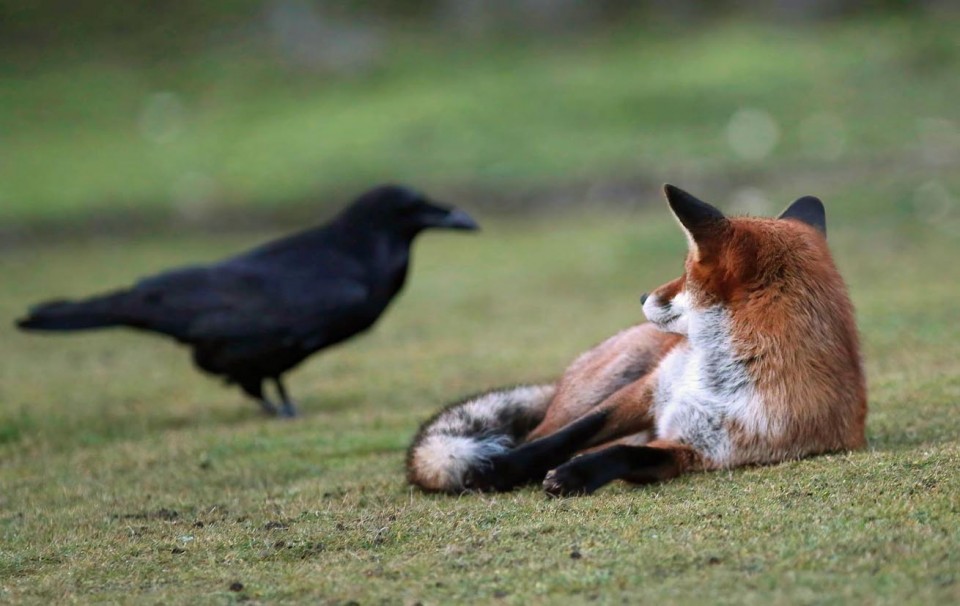
A frequently featured victim is a corvid, typically a crow, although the source of such stories is unknown. In their book Urban Foxes, Stephen Harris and Phil Baker mention watching a pet crow belonging to a friend; said crow would sidle up and peck at the pet dog who was trying to sleep. Harris and Baker considered something similar might explain the source of such "death feigning" stories in foxes. That said, there is apparently some footage, captured by a Russian film maker in 1961, showing a fox lying motionless in the grass with its eyes closed; a crow slowly approaches and, very suddenly, the fox springs round, catches and kills the crow. I have only seen stills taken from this film, but the description Rebecca Gambo gives in her 1995 book, The Nature of Foxes, suggests that the crow was targeted by the fox.
Gambo also recounts a similar story by naturalist and photographer Leonard Lee Rue III, who described how a fox will pick up a stick and play with it on the shore in full view of a flock of ducks, seemingly ignoring the waterfowl. After a short while the fox, appearing to tire of his game, drops the stick and wanders off into some nearby reeds; the ducks then come onshore to investigate the stick and are pounced on by the waiting fox. Again, I know of no empirical evidence of this, but apparently this behaviour was so successful and common that hunters on the New England coast of North America bred special fox-like dogs and trained them to "toll" for ducks in the same manner as the foxes -- this brought the ducks closer to shore, making them easier to shoot.

Finally, there is an interesting passing comment from Michael Chambers in his book, Free Spirit. He notes how his hand-reared vixen would roll on dead animals, suggesting that it may help hide her scent from potential prey. Chambers writes:
"The prey would be unalarmed by the sweet stink of death, but very alarmed by the whiff of a live hunter."
Playing with your food
Once the prey has been caught, the fox will sometimes play with the animal before either eating it or letting it go. Veteran fox-watcher David Henry recounted a fascinating incident from the autumn of 1971, during which the fox he was following pounced and caught a shrew, before carrying it up the hillside and playing with it at a roadway. Henry wrote:
"... the fox is leaping around, dancing about the shrew who runs over to one side of the road before the fox herds it back to the center. After 45 seconds of playing with this animal, the fox then does an extraordinary thing. He picks the shrew up in his mouth, walks back down the slope to where he captured the prey, and then with a toss of the head spits the shrew out directly at a small burrow. In less than a second, the shrew disappears into the hole and out of view."
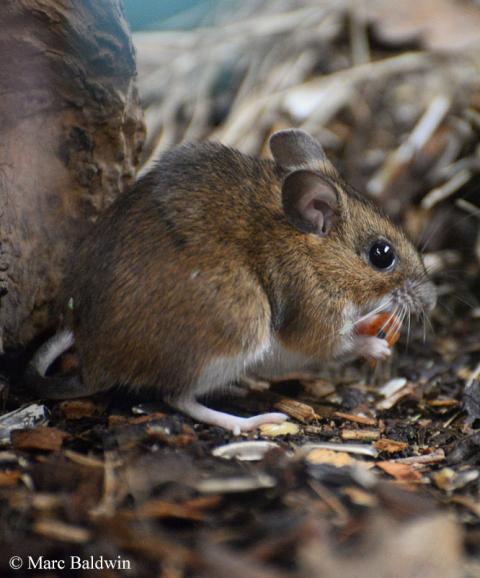
After this remarkable event, the fox apparently turned casually away and trotted back up to the road where it continued to look for more prey. This encounter left Henry in no doubt that the fox had no intention of eating the prey. Moreover, it raises some interesting questions about the fox's understanding of the prey animal -- it took the shrew back to the burrow from which it was caught, rather than just letting it run off into the vegetation on the roadside and find its own way home. Does this suggest that the fox had some inkling that the burrow was in some way important to the survival of the shrew? We cannot say for sure, and a single encounter is not much from which to draw conclusions, but reading it certainly made me think about foxes in a new light.
In, Finding the Fox, his account of watching foxes near the Oslo Fjord in south-eastern Norway, Andreas Tjernshaugen described the same behaviour:
"Soon [the vixen] stopped, body tense. She leaped high into the air and vanished into the long grass. When she backed out again, tail first, she had a mouse-sized object in her jaws. She dropped what I assumed to be a field vole onto the mown grass, then started to stalk it, attacked it, picked it up again, and dropped it. Several times, she leaped into the air, pouncing once again upon the prey she had allowed to escape. There was no doubt about it -- she was playing with this little rodent, roughly the way cats do. After a while, the field vole appeared to give up all attempts at escape, either because it had passed out or was simply paralyzed with fear, or perhaps because its tiny heart had already stopped beating; at any rate, [the fox] started to pick it up and toss her head so that the vole's body flew through the air in an arc and landed a couple of the vixen's body lengths away in the grass -- then she sprinted after it to capture the runaway. She did this time and time again; in all, I saw her hurl her prey away ten times before she eventually lay down and - so it seemed - swallowed it in a single mouthful."
A very similar example of a fox playing with a prey item was recounted to me by Tina Rae. The following is Tina's description of the behaviour she witnessed near Glasgow on the evening of 19th July 2012:
"Last night it was funny...well maybe not for the big mouse or small rat; we couldn't decide what it was. My one eyed fox had found a rodent and we were watching it poking it to make it run down a hill ... when it got to the leafy bit to safety the fox picked it up and took it to the top of the hill again and poked it to make it run again ... he reminded me of a cat playing with a mouse. When he carried it to the top of the hill again he was really gentle picking it up by its tail. This happened at least 20 times 'till Velma (his daughter) appeared from nowhere and grabbed the rodent and ran like hell and jumped over a hedge and her dad chased her."
In 2007, BBC Wildlife reader Rosemary Eustace wrote in to the magazine describing a vixen playing with prey on multiple occasions in Worcestershire. "The rule seems to be "the smaller the prey, the greater the play"", Eustace wrote as she described how adult rabbits and rats provided no entertainment for the vixen with which she was familiar. Rabbit kittens, however, would be allowed to run for a few yards before being caught again and this was a game that could continue for five minutes before they were eventually eaten. Eustace recounts how voles were often caught and released, only to be hunted again, but that shews were the most highly-prized:
"The vixen would toss them high into the air and wait for them to land and stagger off into the grass. She would give them a head start before launching herself in a graceful arc. Sometimes a poor shrew would be stunned. The vixen would lie in front of it, her nose a few inches away, waiting for it to recover and restart the game."
Planning your meal
There is some anecdotal evidence that foxes teach their cubs how to hunt (see Schooling the Cubs) and several naturalists have noted how foxes appear to watch and learn from each other, so a degree of cultural transmission of hunting techniques and strategies is not unexpected. Indeed, foxes are very intelligent mammals and there are several tantalising examples of foxes learning the behaviours of their prey and applying them during a hunt -- problem-solving, if you like. One particular incident was observed during June 1973 in Alaska's Denali National Park by Selkirk College biologist Peter Ommundsen, who described the event in a paper to the Canadian Field-Naturalist in 1994.

Ommundsen watched an Arctic Ground squirrel (Spermophilus parryii) feeding on vegetation when it was approached by a Red fox; the fox charged and the squirrel ducked into a tunnel entrance, narrowly evading capture. Within a minute, the squirrel reappeared at another hole, but within view of the fox, and returned to its feeding site. Again the fox charged and the squirrel escaped back into the same entrance, emerging shortly afterwards from the same exit to resume feeding. The fox was seen to rush at the squirrel a third time, causing it once again to duck into the entrance, but this time the fox:
"... ran directly to the exit, where it waited with mouth open. The squirrel promptly appeared at the exit, as it had on the two previous occasions, and was immediately captured by the fox."
This example is quite remarkable because it demonstrates problem-solving behaviour by the fox, and such encounters are rarely observed in the wild. Another example, this time of cooperative hunting, is given by Chris Ferris in her 1988 book, The Darkness is Light Enough. Ferris described how the dog fox would position himself on one side of a favourite rabbiting field and the vixen would launch an attack from the other, catching a rabbit in the process. The appearance of the vixen sent the rabbits bolting for cover, towards the dog fox, who would dart out and catch a couple of the panicked rabbits. This goes above and beyond Ommundsen's account in that there must have been some previous 'planning' and communication of the plan in order for it to function properly.
In the late 1970s, Russian researchers demonstrated that foxes were capable of novel extrapolative behaviour in locating food (i.e., when someone moved the food out of view, the foxes started looking for it). This may sound pretty basic, but understanding object permanence (i.e., the ability to realise that something has been hidden and can thus be found, rather than having disappeared) is quite a big deal in behavioural circles and such systematic searches for hidden objects (such as where the heck did I leave my car keys?.) is not something human babies do until they're about a year old. The researchers found that some foxes were better than others at such object permanence tests.
At this point, it's worth remembering that none of this should really surprise us: foxes get hungry and go out hunting for food that's essentially hidden every day. I think there is a tendency for us to view animal behaviour in an overly clinical manner, considering that humans are in some way superior to other animals because we have such domination of our environment. Ultimately, humans are animals too and, far from being disassociated from nature, we are intricately connected to it. Invariably there is a need for a level of logical and dispassionate analysis of behaviour, but referring to a behaviour as "instinct" should not devalue it.

Another aspect of fox hunting behaviour that is oft-cited but often regarded as folklore is that a fox always hunts away from home. In other words, a fox will never take chickens from a coop in its territory so as not to draw attention to itself. Indeed, in his 1975 book, Thorburn's Mammals, Scottish naturalist and painter Archibald Thorburn wrote:
"I was told that the vixen never interfered with some fowls living close at hand, but would always forage for food at a distance. She was no doubt wise enough to know that her young might be endangered if depredations occurred near home."
This would certainly seem like a "cunning" plan, but I am not aware of any evidence to support it.
Striking it lucky
There aren't many statistics on the hunting success of foxes; my own experience suggests this may be at least partly because, even when hunting is observed, prey is consumed so quickly it's difficult to be sure if the fox was successful or not (particularly when the animal is hunting voles in long grass, giving only occasional views). We do know, however, that hunting success varies with the type of prey being targeted.
During his numerous walks around the boreal forests of Canada observing Red foxes, the eminent ecologist J. David Henry observed 434 completed hunts (i.e., where some attempt was made by the fox to pin and bite the prey) by 22 foxes. Henry noted that 139 (32%) of these hunts were successful and that there was an interesting variability between the success of the fox and the type of prey. Foxes successfully caught insects 82% of the time, mammals 23% of the time, and birds only 2% of the time. Observations by David Macdonald in Oxford suggest that a fox is successful at catching rodents in about three-in-five pounces (i.e., 60%). A similar picture was revealed by Mark Bekoff and Mike Wells during their studies on coyotes (Canis latrans), which, like foxes, frequently hunt small mammals; they found that, on average, adults were successful at catching rodents about 25% of the time, with considerable variation according to the species they were hunting. When targeting voles, for example, coyotes succeeded in only 18% of hunts, while they caught gophers 83% of the time.
Bekoff and Wells also found that hunting success varied with habitat, with coyotes being three-times more successful hunting in short than long grass. An overall success rate of just about 30% is in line with many other predators: compare golden eagles (Aquila chrysaetos) and peregrine falcons (Falco peregrinus), which are successful about 20% of the time; Nile crocodiles (Crocodylus niloticus) that successfully ambush black wildebeest (Connochaetes gnou) about 30% of the time; and grey wolf (Canis lupus) packs that successfully bring down elk (Cervus canadensis) in 45% or more cases.

It is tempting to suggest that this success rate is probably related to maturity and, hence, experience, as is known in many animals.
In his book, Free Spirit, Michael Chambers described how his hand-reared vixen 'Ferdi', as a cub, hunted with uncertain, doubt-filled inefficiency; catching her quarry only once in every four or five attempts (20-25% success). Within a few weeks, however, she could catch a dozen small mammals in a 20 minute pouncing session, with almost infallible technique. Ferdi did, it seems, take much longer to become proficient at catching rabbits. Chambers also described what appeared to be Ferdi teaching her cubs to hunt, using a multi-staged approach which is covered in more detail later.
Similarly, in 1980 paper to Zeitschrift für Tierpsychologie on worm-catching behaviour in foxes, David Macdonald described an adult female (TP♀) apparently teaching one of her cubs how to catch worms during June 1974. The cub had been trying to catch worms using a mousing pounce but ran over to his mother when she successfully caught a worm. Macdonald wrote:
"This time the vixen did not draw the worm free from its burrow, but held it taut and let the cub take it from her. He grabbed it and broke it. TP♀ caught another worm and again let her cub take it. The next worm she caught was deeply lodged in its burrow and she could barely grip it. Normally a fox would simply break off the end of the worm in these circumstances. However, TP♀ began to tap the worm gently with her forepaws. This action eased the worm further out of its burrow until the cub again took hold of it."
After this the cub started foraging using its mother's technique, although failed to catch anything. When Macdonald saw the vixen and cub two weeks later, however, both were foraging in the same field using the same technique, with the mother apparently more successful than the cub (4 worms per min vs. 1 worm per min, for mother and cub). During a final observation of the two some time later, Macdonald commented that "they had the same capture rate".
Additionally, during their study of fox diet along the foreshores of Lake Burrendong in New South Wales, Robyn Molsher and her colleagues observed that, overall, rabbits and small mammals were eaten less often on nights when there was a full moon than during other moon phases, suggesting ambient light might affect hunting success in some habitats. In spring, foxes tended to eat rabbits more often on new moon nights.
Table manners
Foxes do not have a particularly powerful bite when compared to other carnivorans and prey is typically killed by a bite to the back of the neck, severing the cervical vertebrae. The head may be removed and either eaten separately to the body, or cached for subsequent retrieval. In some cases the head and body may be cached in separate places and foxes are known to eat the head and apparently leave the body.
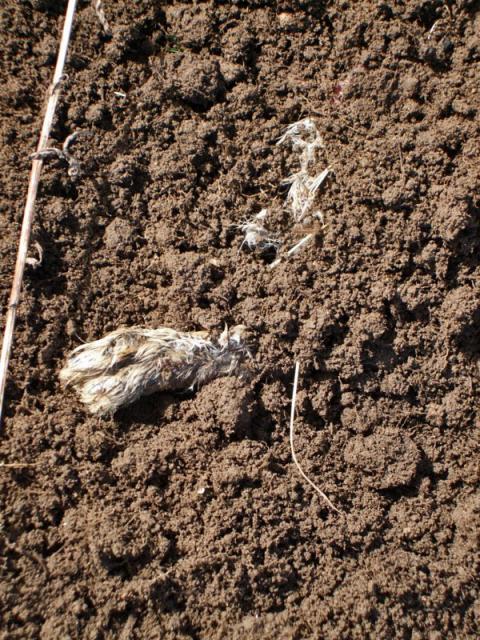
Removal of the head and leaving the body is a behaviour that is frequently associated with domestic situations (i.e., small pets or livestock kept in gardens) and the reason they sometimes do this is unknown. It may be associated with surplus killing behaviour (see QA) or it may reflect an abundant environment in which the fox can be more choosy as to its diet. In their 1985 text Biochemistry and the Central Nervous System, McIllwain and Bachelard note that the mammal brain is a good source of glucose, while also being about 12% fat (mostly myelin in the nerve cell linings) and 8% protein; cerebrospinal fluid is mainly water, but does also contain glucose and important minerals such as sodium, potassium, calcium and magnesium.
Foxes tend to consume their kills in a fairly predictable manner. Ecological consultant, and experienced naturalist, Dan Lombard described to me his experience of fox kills. The following is slightly modified from his original discussion and reproduced here with his permission:
"I find foxes and badgers will break in through the naval, vent, and ventral area -- as opposed to the neck -- and feed around the back of the rib cage. I found quite a good example of this the other day. Foxes tend to eat most of the organs; badgers are pickier and always leave the caecum. This is presumably due to foxes being more able to digest grass, compared with badgers. The head is removed and the organs eaten; I then find the back legs are stripped to the bone, with the foot from the ankle down, left untouched. A lot of the time the fore quarters are left, although again the body may be slit in two and cached apart or together."
Indeed, in his book Free Spirit, Michael Chambers described how, on several occasions, the vixen he reared from an abandoned cub caught a rabbit and split in neatly in half using her carnassials before carefully burying each half separately. Foxes may cache a carcass immediately after obtaining it, or consume part of it before burying the leftovers for subsequent retrieval.